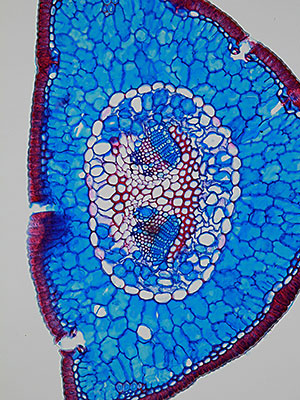
Photo: Fritz Schweingruber / WSL
The increase in atmospheric CO2 concentration has allowed trees across Europe to use their available water resources more efficiently. Over the 20th century, the so-called water use efficiency has risen nearly 20% from the increase in atmospheric CO2 concentrations. These results are reported by an international research team led by David Frank from the Swiss Federal Research Institute WSL in today’s online release of the journal Nature Climate Change.
Trees, through tiny pores on their leaves called stomata, take up carbon dioxide from the air and produce carbohydrates for their growth. Through these same stomatal pores, tree emit water vapor: over 100 kilograms of water is released to produce one kilogram of carbohydrate. When the CO2 concentration in the air increases, the size of the stomatal opening can be regulated, to simultaneously maximize the amount of carbon acquired and minimize the water lost. The so-called water use efficiency increases.
In this new study, an international consortium of researchers have integrated measurements of carbon isotopes from tree-rings and dynamic global vegetation models (DGVMs) to quantify tree and forest responses to both climate variation and increased atmospheric CO2 concentrations.
Tree-rings from sites spanning Morocco to Norway were investigated
“Tree-ring data provide one of the unique opportunities to obtain long-term records of ecosystem responses to climate change”, said David Frank, a Dendroclimatologist at the Swiss Federal Research Institute WSL and collaborator at the Oeschger Centre for Climate Change Research, University of Bern.
The researchers utilized a network of isotope data from 23 tree-ring sites spanning Morocco to Norway to quantify variation in metrics of water use efficiency – the amount of water required to assimilate a given amount of carbon – and a basic measure of plant and ecosystem economy.

Experimental and theoretical lines of evidence suggest that plant stomata regulate gas exchange, namely water transpiration and CO2 uptake by leaves, to simultaneously maximize carbon gain and minimize water loss. These leaf-level processes also result in the preferential incorporation of the lighter 12C carbon isotope.
“By measuring the ratios of heavy to light carbon isotopes of tree-ring cellulose we are able to reconstruct various physiological metrics such as water use efficiency and their environmental drivers”, said Kerstin Treydte co-author of this study and a specialist in tree-ring isotopes at the WSL.
The researchers used statistical techniques and the model simulations to estimate the independent effects that both climate variation, such as regional warming, and increases in atmospheric CO2 concentrations have on the isotope discrimination and plant water use efficiency. They determined that broadleaf species increased carbon gain per potential unit water lost (intrinsic water-use efficiency; iWUE) by 14% and needleleaf species increased iWUE by 22%.
By accounting for climate change and its influence on stomatal behavior, this study provides a benchmark for the strength of tree responses to increased CO2 concentrations – a figure questioned in the current scientific literature. The researchers found that the long-term responses are consistent with plant maintenance of a constant ratio of inter-cellular to atmospheric CO2. This finding supports the short-term experimental evidence being also indicative of plant physiological responses to gradual increases in atmospheric CO2 concentrations.
One of the key uncertainties in global climate projections is how the models represent the carbon cycle. “We were able to compare the tree-ring based estimates with various vegetation models and were pleased to see tight agreement. This sort of testing helps us understand where we can further develop models, or in this case gives us confidence in the model projections for these ecosystem metrics”, said co-author Chris Huntingford, a climate modeler at the center of Ecology and Hydrology in the United Kingdom.
Transpiration increases despite greater water use efficiency
Next to investigate the impact of these physiological changes on the regional water balance, the researchers turned again to the ensemble of the DGVM simulations. The models showed that the increase in water use efficiency did not translate into a reduction in transpiration. Instead, over the 20th century, a lengthening of growing season, increases in leaf area, and greater evaporative demand contributed to increasing annual transpiration that countered any net savings from changes in iWUE. It thus seems unlikely that plants will reduce the surface to atmosphere flux of water vapor – a strong greenhouse gas. It is also unlikely that plant responses to increased CO2 will substantially increase soil moisture or river run-off.
“These findings illustrate the importance of scaling sub-organismic processes such as stomatal response to the tree-level and the ecosystem scale using a combination of model-data integration approaches” said Ben Poulter, a vegetation modeler at Montana State University. He continued, “Deep insights into the complex array of earth system feedbacks are only possible by coordinating large interdisciplinary research teams and approaches integrating both empirical data and model results.”
For more information
D. Frank et al.: Water-use efficiency and transpiration across European forests during the Anthropocene. Nature Climate Change, online May 11, 2015.
Source
Eidgenössische Forschungsanstalt für Wald, Schnee und Landschaft WSL, press release, 2015-05-11.
Supplier
Centre for Ecology and Hydrology
Eidgenössische Forschungsanstalt für Wald, Schnee und Landschaft WSL
Montana State University
Universität Bern
Share
Renewable Carbon News – Daily Newsletter
Subscribe to our daily email newsletter – the world's leading newsletter on renewable materials and chemicals









